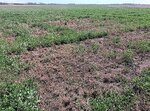South Dakota Extension forage field specialist
Fall alfalfa management
As fall approaches and temperatures decrease, it’s important to decide whether that last late cutting is really worth it. I like to bring this up each year to …
This item is available in full to subscribers.
To continue reading, you will need to either log in to your subscriber account, below, or purchase a new subscription.
Please log in to continue |


As fall approaches and temperatures decrease, it’s important to decide whether that last late cutting is really worth it. I like to bring this up each year to remind growers about the trade-offs that come with late alfalfa cuttings.
Alfalfa requires about 500 uninterrupted growing degree-days to winterize- this translates to roughly six weeks (depending on temperatures). Alfalfa winterization typically begins about three weeks prior to the average date of the first 32°F frost. In South Dakota, this usually means late September to early October (go here for frost dates in your area).
Alfalfa plants determine winterization based upon day length and cooling average daily temperatures, hence the first average frost guideline. Plants cut during the winterization period will attempt to put on regrowth; this takes away from their ability to accumulate root proteins and carbohydrates, which may cause poor stand and vigor the following spring (think of a bear preparing for hibernation). It’s important to weigh the odds of an additional cutting against potential stand losses.
To avoid winter injury next spring, it is best practice to leave the alfalfa in the field at this point per the frost date in most of South Dakota. However, if you had late cuttings this year (as many did) and are in need of feed there are a few things to consider:
Alfalfa stands may last several years in various parts of South Dakota. Taking care of stands and skipping late fall cuttings can help prolong plant vigor and overall stand for years to come; however, challenging years (like this one in many parts of SD) may have created forage shortages and require producers to make tough decisions. For more information on alfalfa see the forage page on our website.
The SDSU Crop Performance Testing program released the most recent winter wheat variety trial results recently. The crop performance testing program has been a popular, reliable, unbiased seed testing program in South Dakota for many years, turning over reliable data for public consumption.
This year, grain trials were held at Brookings, Faith, Hayes, Mount Vernon, Onida, Pierre, Platte, Selby, South Shore, Sturgis, Vivian, Winner, and Wall. Forage trials were conducted at Brookings and Pierre. Find a trial near you to aid in decision making for this year’s crop!
Please go here to see the results digitally at any time. Don’t see your favorite line or company represented? These trials are open, paid entry trials; it is up to each individual company/university to enter their varieties for testing. If you’d like to see more representation, contact your seed dealer about considering entry into these valuable trials!